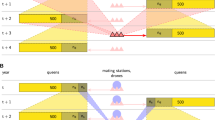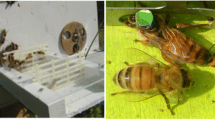Summary.
The genetic variance of queen mating frequency was studied in honeybees (Apis mellifera carnica). Worker offspring (N = 966) of 28 naturally mated half sister-queens (r = 0.25) from seven unrelated breeding lines were genotyped at four DNA microsatellites. The mating frequencies of the queens were derived from the offspring genotypes. The number of observed matings per queen ranged from 10 to 28 with an average of 17.32 ± 1.10 (number of estimated matings: 24.94 ± 2.51; number of effective matings: 20.09 ± 1.73). Half-sib analyses of the breeding lines were used to estimate heritability. Heritability was h2 = 0.449 ± 0.135 for the estimated number of matings and h2 = 0.262 ± 0.103 for the number of effective males, which are both significantly different from zero. We conclude that a high genetic variance for polyandry in honeybees can be favored by balanced selection between individual queen and colony level.
Similar content being viewed by others
Author information
Authors and Affiliations
Corresponding author
Additional information
Received 16 October 2003; revised 4 May 2004; accepted 4 May 2004.
Rights and permissions
About this article
Cite this article
Kraus, F.B., Neumann, P. & Moritz, R.F.A. Genetic variance of mating frequency in the honeybee (Apis mellifera L.). Insectes Soc. 52, 1–5 (2005). https://doi.org/10.1007/s00040-004-0766-9
Issue Date:
DOI: https://doi.org/10.1007/s00040-004-0766-9




